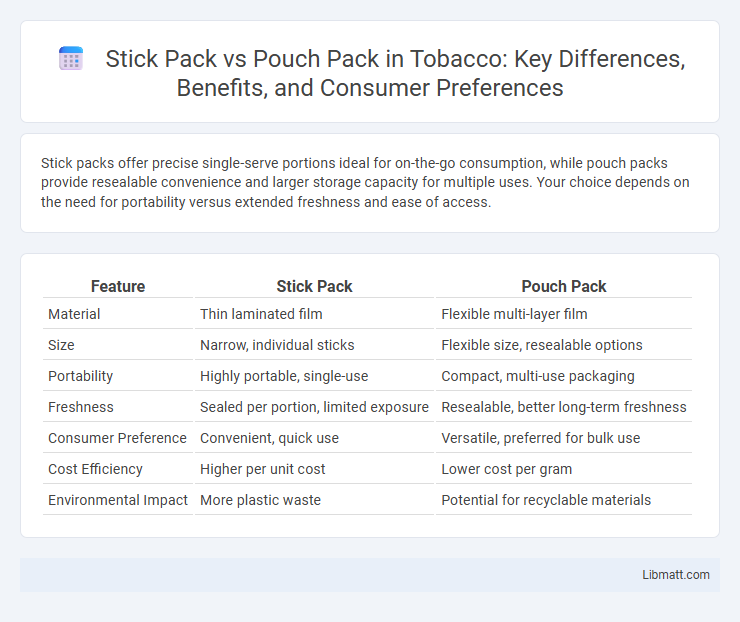Stick packs offer precise single-serve portions ideal for on-the-go consumption, while pouch packs provide resealable convenience and larger storage capacity for multiple uses. Your choice depends on the need for portability versus extended freshness and ease of access.
Table of Comparison
| Feature | Stick Pack | Pouch Pack |
|---|---|---|
| Material | Thin laminated film | Flexible multi-layer film |
| Size | Narrow, individual sticks | Flexible size, resealable options |
| Portability | Highly portable, single-use | Compact, multi-use packaging |
| Freshness | Sealed per portion, limited exposure | Resealable, better long-term freshness |
| Consumer Preference | Convenient, quick use | Versatile, preferred for bulk use |
| Cost Efficiency | Higher per unit cost | Lower cost per gram |
| Environmental Impact | More plastic waste | Potential for recyclable materials |
Introduction to Stick Pack and Pouch Pack
Stick packs are slender, sealed packets commonly used for single-serving powdered or granular products such as sugar, instant coffee, or supplements, offering precise portion control and easy portability. Pouch packs are flexible, resealable bags often utilized for snacks, pet food, or liquids, designed to preserve freshness and provide convenience through resealing features. Both packaging types enhance product protection and consumer usability, yet differ significantly in shape, volume capacity, and application suited for various industries.
Overview of Packaging Types
Stick packs offer a slim, elongated design ideal for single-serve products like powders and liquids, providing precise portion control and easy on-the-go use. Pouch packs, available in various sizes and with resealable features, accommodate bulkier or multiple servings, enhancing product freshness and convenience. Choosing the right option depends on your product type, portion needs, and consumer usage preferences.
Material Composition Differences
Stick packs are typically made from multilayered flexible films combining materials like polyethylene, polyester, and aluminum foil to ensure durability, moisture resistance, and product freshness. Pouch packs often utilize similar multilayer laminates but may include additional structures such as thicker foil layers or resealable zippers for enhanced protection and convenience. Your choice between stick pack and pouch pack should consider these material composition differences based on the product's storage needs and shelf life requirements.
Space Efficiency and Portability
Stick packs offer superior space efficiency with their slim, linear design that allows for easy stacking and minimal storage footprint compared to bulkier pouch packs. Pouch packs provide greater portability due to their resealable features and flexible structure, making them convenient for on-the-go use. Choosing between these packaging options depends on Your specific need for compact storage or ease of transport.
Product Protection and Shelf Life
Stick packs offer superior product protection due to their airtight, tamper-evident seals that prevent moisture and oxygen ingress, extending the shelf life of sensitive products. Pouch packs, while versatile and resealable, may provide less barrier protection compared to stick packs, potentially impacting product freshness if not properly stored. You should choose stick packs for maximum preservation in single-serve applications, whereas pouch packs are ideal for products requiring frequent access.
User Convenience and Ease of Use
Stick packs offer superior portability and single-serve convenience, making them ideal for on-the-go users who need quick access without the hassle of resealing. Pouch packs provide resealable options that extend product freshness and allow multiple uses, enhancing user convenience for storage and repeated consumption. Depending on your lifestyle, stick packs streamline immediate use, while pouch packs optimize long-term usability.
Branding and Design Opportunities
Stick packs offer a slim, uniform shape that enhances shelf visibility and allows for consistent brand messaging with ample space for logos and vibrant graphics. Pouch packs provide a larger printable surface, enabling complex designs, detailed product information, and versatility in shapes that reinforce brand identity. Both formats support high-quality printing technologies that elevate packaging aesthetics and strengthen customer recognition.
Environmental Impact and Sustainability
Stick packs generally use less material than pouch packs, resulting in a smaller carbon footprint and reduced waste. Pouch packs offer better resealability and reusability, which can decrease overall packaging waste when consumers store unused products. Both packaging types can be optimized with recyclable or biodegradable materials to enhance environmental sustainability.
Cost Considerations for Businesses
Stick packs generally offer lower material costs and efficient packaging speeds, making them ideal for businesses aiming to reduce per-unit expenses. Pouch packs, while often more expensive due to higher packaging material and sealing requirements, provide better product protection and shelf appeal, potentially increasing product value and customer satisfaction. Evaluating your product type and target market helps determine if the cost savings of stick packs outweigh the marketing benefits of pouch packs.
Choosing the Right Packaging for Your Product
Stick packs offer precise portion control and are ideal for single servings of powders or liquids, enhancing convenience and reducing waste. Pouch packs provide larger, resealable options suitable for bulkier products, offering extended freshness and easy storage. Choosing the right packaging for your product depends on factors like portion size, user convenience, and product shelf life to maximize customer satisfaction and brand appeal.
Stick pack vs pouch pack Infographic

 libmatt.com
libmatt.com